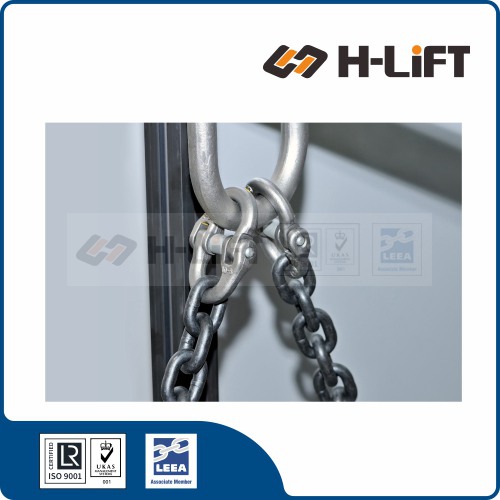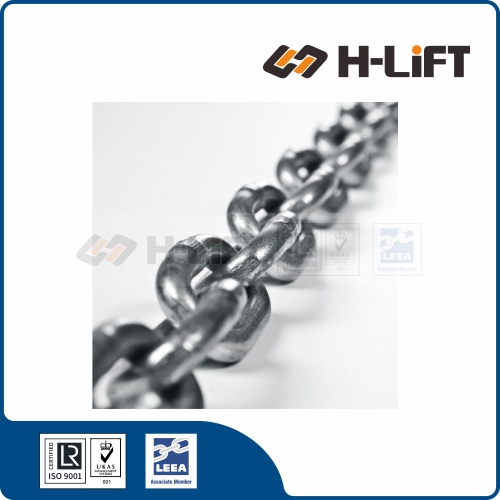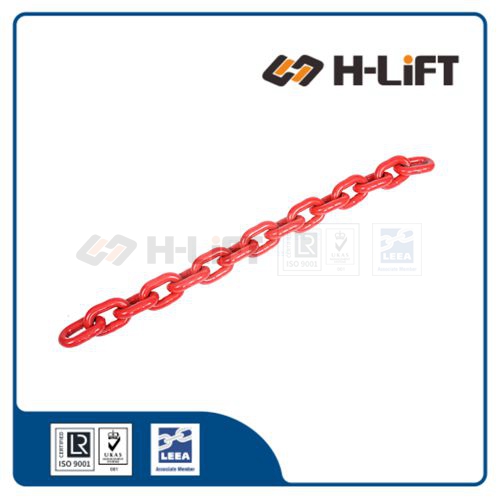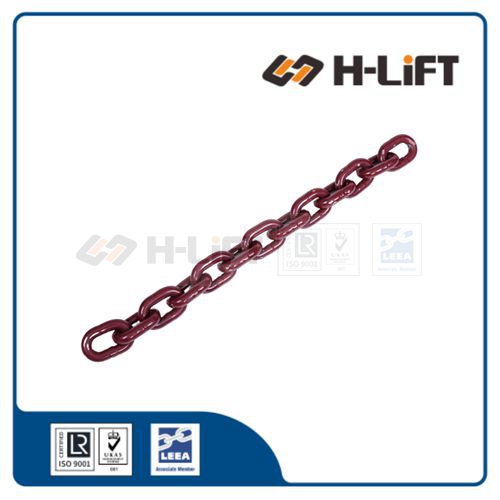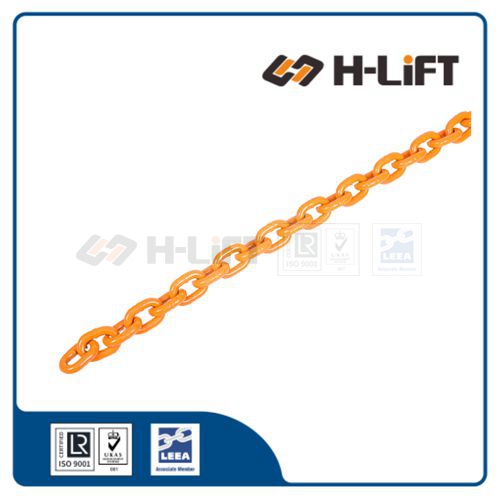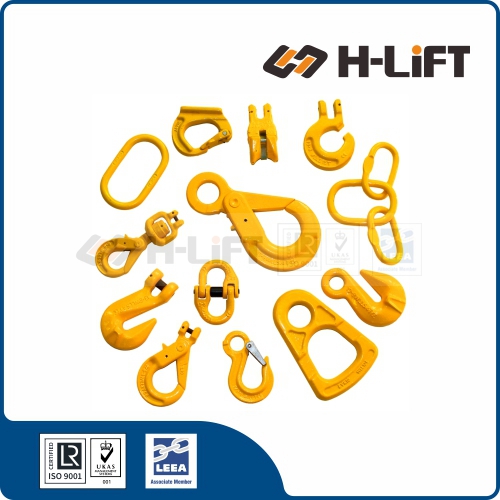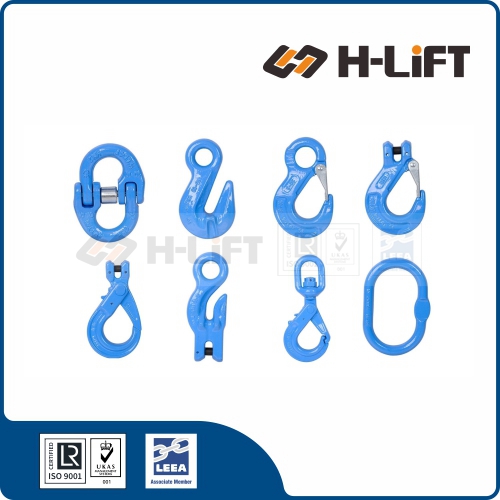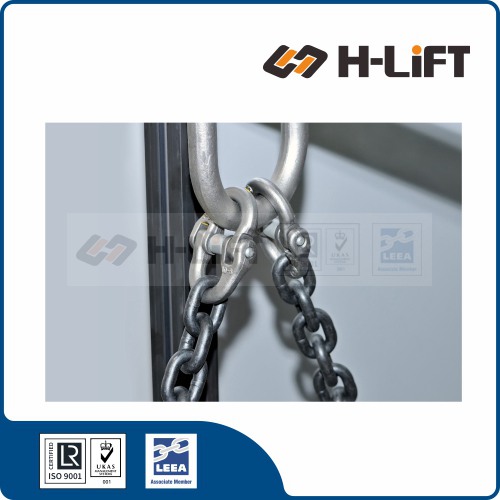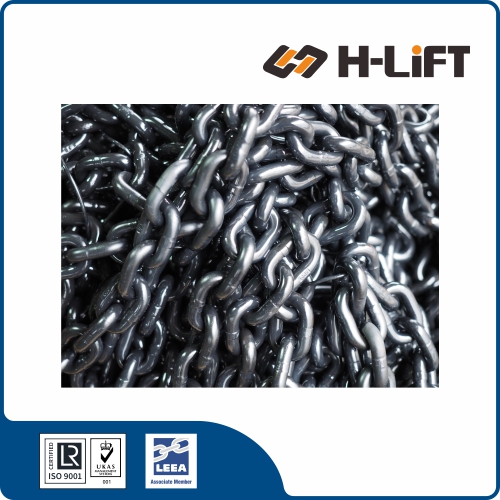What is the Difference Between Different Grades of Welded Chain?
Welded chain comes in various different strengths, referred to as “grades” on the market. The grade, indicated by a number, represents the strength—or mean stress value—of the chain. As the chain grade number increases:
- The material of the chain is typically harder and more resistant to abrasion
- Strength-to-weight ratio increases
- Working Load Limit (WLL) increases
The number that indicates the grade of the chain is a representation of the solution to a mathematical equation. This equation takes the tensile force of the chain —measured in Newtons—and divides it into the cross-sectional area of the link size on that chain in millimeters.
The simplified equation is as below:
Newtons / millimeters2
From this equation, you get the number that corresponds to the grade of the chain. The higher the grade number, the higher the tensile force is in comparison to the size of the chain links—resulting in a higher strength-to-weight ratio.
The biggest difference between grades of chain is that carbon steel chain: Grade 30, 43, and 70 is not recommended for overhead lifting, while alloy steel chain: Grade 80, 100 is recommended for use in sling assemblies and overhead lifting applications.
There are two main catagories of welded steel chain:
Carbon steel chain and Alloy steel chain
Carbon Chain
Carbon chain is most commonly used for tie down and container securement purposes and is not recommended for overhead lifting.
Grade 30 Carbon Chain
This is the lowest chain grade available on the market when it comes to graded welded chain, and is commonly referred to as “proof coil.” Grade 30 is a rather generic type of chain that can be used anywhere from logging, trucking tie downs, or even on playground equipment.
As mentioned above, carbon chain, in general, is commonly used in bundling applications where alloy chain is typically not permitted. In fact, the lower the carbon content in the chain for bundling applications, the better. So, it is not uncommon to see Grade 30 chain as part of sling assemblies used for bundling.
Grade 43 Carbon Chain
While Grade 43 chain has a slightly higher strength-to-weight ratio in comparison to Grade 30, the two chain grades are often used interchangeably. Grade 43 Chain is commonly referred to as “High-Test Chain,” and is most often used for:
- General utility
- Towing
- Load securement
Grade 70 Carbon Chain
Grade 70 chain is the highest grade you can purchase within the carbon chain category. Like Grade 30 and 43 chain, it is not recommended for overhead lifting. Unlike Grade 30 and 43 chain, it is heat-treated, making it more resistant to wear and abrasion as it is a harder material with a higher strength-to-weight ratio.
Also known as “Transport Chain,” Grade 70 chain is most commonly used for tie down and load securement applications for trucking and other cargo. While Grade 30 and 43 chain can also be used for load securement, Grade 70 chain provides a stronger, more durable option with a much higher strength-to-weight ratio.
Grade 70 chain is most commonly manufactured with a gold-colored finish and is recognized throughout the industry as such. When trained properly, this can be an easy identifier for riggers to make sure they avoid using it for lifting applications.
Alloy Steel Chain
Unlike carbon chain, all graded alloy steel chain is recommended for overhead lifting applications. Meaning, alloy chain may also be used to construct chain sling assemblies for overhead lifting in addition to the various securement applications that carbon chain is capable of.
Alloy chain is recommended for overhead lifting because its higher strength-to-weight ratio provides a product that is capable of a much higher elongation percentage—20% minimum—before breaking when overloaded. Basically, higher chain grades correlate with stronger material and a higher resistance to bending or breaking in the event of impact or overloading.
Grade 80 Alloy Steel Chain
Grade 80 chain is recommended for overhead lifting applications and is most commonly used in sling assemblies.
Grade 100 Alloy Steel Chain
Like Grade 80 chain, Grade 100 chain is recommended for overhead lifting applications and is most commonly used in sling assemblies.
In comparison to Grade 80, Grade 100 chain has a significantly higher strength-to-weight ratio—about 25% higher, depending on the manufacturer. Grade 100 chain also has a slightly harder surface material, which gives it some advantage when it comes to abrasion resistance.
In most cases, either Grade 100 or Grade 80 chain can be used for the application. The only situation in which Grade 100 chain may be necessary is if the application is heavily concerned with the strength-to-weight ratio of the lifting sling, as Grade 100 chain slings have the advantage there.
It is much more common for mistakes involving chain and use of correct chain grade to be made by uninformed, or untrained, riggers. This is why it is extremely important for the safety of your personnel and equipment to ensure that your riggers are trained properly.
The three most common problems they encounter when it comes to chain and chain grade are:
- Using hoist load chain for lifting applications
- General misuse and abuse of alloy chain
- Use of Grade 70 chain for overhead lifting
Using Hoist Load Chain for Lifting Applications
Load chain—the chain used inside a hoist—is constructed very differently from the alloy chain used in slings for overhead lifting. One common problem is riggers in a facility using the hoist chain to wrap around / connect directly to loads for overhead lifting. There are several reasons that this is not compliant:
- Load chain is designed specifically for use within the inner workings of a hoist. It is NOT graded for directly connecting to and lifting a load as a sling would.
- Load chain does not meet the same elongation or hardness requirements as a Grade 80 or Grade 100 chain does.
- If the lift causes any deformation in the load chain, when it is retracted back into the hoist, it could cause damage to and destroy the hoist.
- Load chain is designed specifically for the hoist that it is installed in. It is not graded for the stress and rigor of overhead lifting that alloy chain slings are recommended for.
General Misuse and Abuse of Alloy Chain
The second most common problem is general misuse and abuse of chain slings. General misuse and abuse of alloy chain slings refers to, but is not limited to:
- Improper storage of equipment, such as leaving slings laying around the shop floor.
- Failing to get frequent enough inspection of your slings (based upon the severity of the application).
- Frequent overloading or improper usage of slings.
- Ensuring proper maintenance and storage of your lifting slings is extremely important for both safety of personnel and preserving the life of your equipment. When you don’t properly protect and maintain your lifting slings, you increase the chances of a dropped load, damaged property, injury, or worse.
Grade 70 Chain Used for Overhead Lifting
Another common mistake is the use of Grade 70 chain assemblies used in place of a comparable Grade 80 or Grade 100 single-leg chain sling.
As we talked about above, Grade 70 chain is not recommended for use in overhead lifting applications. The WLL, strength-to-weight ratio, and elongation factors simply do not meet the same expectations required by Grade 80 and Grade 100 chain.







